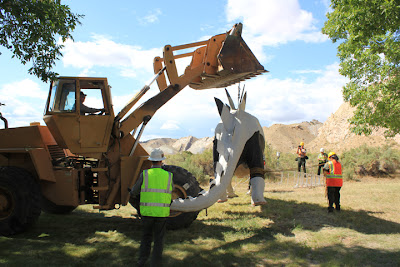The best known of these segments involves a real life battle between an alligator and a goanna lizard.The alligator was made appropriately dinosaurian by having a large sail glued onto its back, a la Dimetrodon (which is not a dinosaur and is actually more closely related to mammals, including you and me, than dinosaurs).
The battle segment lasts several minutes and there is biting, slashing, thrashing, roaring and bellowing, and death rolling (by the alligator). Sometimes the goanna has the upper hand…
Sometimes the alligator.
Ulimately the goanna is actually killed by the alligator and the camera rolls close up to the twitching, bleeding, and dying lizard. It’s brutal and unnecessary.
This dramatic footage has been recycled in many subsequent B-flicks. The award for its use least relevant to the story line of a film goes to the infamous 1953 Robot Monster (aka Monsters from the Moon), a film considerably worse than Plan 9 From Outer Space but infinitely better than The Creeping Terror.
 |
| The unforgettable Robot Monster. |
Thankfully modern film standards and the public would not brook such battle-to-the-death nonsense today. However, we still see this kind of thing replayed in real life, most recently in the US Congress. There’s lots of false posturing, roaring bravado, and transparent pretending (like the phony sails, horns, and frills in OMBC) that goes on there. And like the movie real blood is sometimes drawn. Take the 2012 Federal Budget as an example.
The fiscal year for the federal government starts on Oct. 1. Without a budget bill passed government facilities shut down, employees are furloughed, and National Park campgrounds are emptied and the parks gated and closed to the public. Last week the House of Representatives passed a continuing resolution, a stop gap funding measure to keep the government open until mid-November. They sent it on to the Senate, promptly left Washington DC, and are out all this week. The Senate rejected the House bill. So with less than a week to go there was no funding bill for anyone to agree on and half the players weren’t even around. The Senate then passed a different version of the bill and parliamentary procedure allowed three Representatives to call a House meeting and approve the Senate bill. Whew, close call you say? Well closer than you think and we’re not out of the woods yet.
The bill passed by the House and Senate only funds the Federal government THROUGH MIDNIGHT OF OCTOBER 4! Fortunately, the 4th is the day for the Grand Reopening of the Quarry Exhibit Hall and the wall of dinosaur bones. Being funded through midnight of the 4th will let us have that opening as planned. However, it also means that we will not be able to open after the 4th until a new budget bill is passed. So after five years of closure and planning and 18 months of hard construction work on a $7 million dollar project we may be in the position of reopening the building on the Oct 4th 2011 and immediately closing it on Oct 5th 2011. Can this be avoided? Maybe, but the House will not even reconvene until 2:00 PM on Monday October 3.
In its history the US government has closed down 17 times. In my 30+ years of federal employment I can count on one hand the number of times we’ve had a full year budget by Oct 1. In some years we hobble by on continuing resolutions through March or even April. Living by my personal motto --- that you are only a cynic if you’re wrong, otherwise you are a realist --- I banked on past experience and placed some heavy bets with Paulie Walnuts that we wouldn’t even be able to open on the 4th. Who would have guessed I’d be blindsided by a pro forma session of the House? I guess it’s true, there’s no sure thing in life.
Photos:
Second photo: http://blackholereviews.blogspot.com/2011/08/one-million-bc-1940-original-tumak-and.html
All other photos (exclusive of Robot Monster): http://stoneagecinema.blogspot.com/2009/03/7-one-million-years-bc-1940.html
Robot Monster: http://www.planetvideo.com.au/cgi-bin/mt/mt-search.cgi?blog_id=1&tag=movie%20robots&limit=20
























































